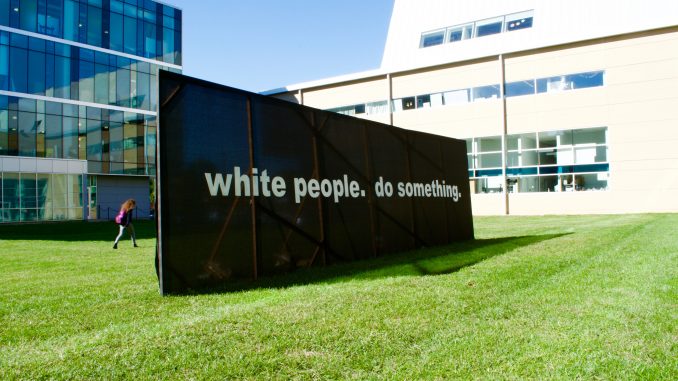
“White people. Do something,” reads graduate sculpture student Kara Springer’s latest installation, which has been on display outside the Tyler School of Art since Sept. 22.
“I think it’s a needed message,” said Jennifer Zarro, a 1999 art history alumna and visual studies professor. “A work of art that does exactly what art should do, which is to get us thinking about things and looking at ourselves and the world differently.”
Zarro teaches two sections of Race, Identity, and Experience in American Art, a race and diversity General Education course at the Tyler School of Art.
“It’s only gotten more and more important to make sure we’re talking about race and diversity and to make sure we’re finding ways to understand each other and learn about each other. I think [the race and diversity Gen-Eds] do a good job at that, giving students and even the professors who teach them an opportunity to speak about these issues,” Zarro said.
Landry Bado, a junior architecture major who was looking at the installation at Tyler, thinks the purpose of the piece was to inspire viewers to “take action regarding social justice issues.”
“I think she just wants them to be proactive and fight against those issues,” he added.
Scott Gratson, the director of communication studies at the School of Media and Communication and a Ph.D. candidate at Tyler, said he has been involved with campus-wide social justice since he started college.
“Even at that point I was involved in LGBT activism, which was difficult. We’re talking the 80s which was a different era,” he said. “This was Reagan, the beginning of AIDS. It was pretty harsh and difficult to try and create social justice for the LGBT community.”
Almost three decades years later, senior glass major Johnny Folliard is still trying to work towards equality for the LGBTQ community.
In a performance, Folliard danced naked while junior glass major Sabrina Fasano, among others, threw balloons at him with fake blood inside. The balloons had derogatory statements toward the LGBTQ community written on them. Folliard said the performance confronted “gay dating apps and how they erode the idea of the LGBTQ community.”
“[Johnny’s art] made my mouth drop,” Fasano said. “Johnny’s a really good dancer, but also what he wanted us to do.”
Folliard uses his performances to express his political and social concerns.
“These performances make up something that functional and design work kind of lacks for me,” Folliard said. “I love blowing glass, that’s how I got into Tyler. It’s one of my passions … but it’s kind of lacking in a sense that having a pretty object at the end of the day is just having a pretty object, it’s not fulfilling. … Performance work gives me more of something, something that satisfies something deeper inside.”
Zarro said art has always been an outlet to express the “deepest human thought and desires and emotions and narratives.”
“Not just visual art, but music and novels and poems and movement and performance and dance,” she added. “I mean those historically seem to be the places that humans, in general, can communicate in very deep, powerful ways.”
Devon Lamb can be reached at devon.lamb@temple.edu.


Be the first to comment